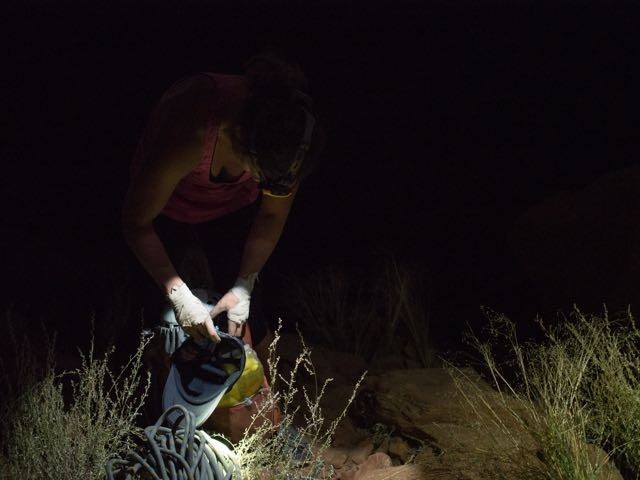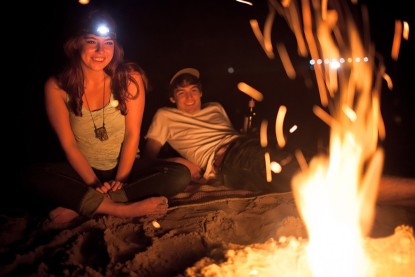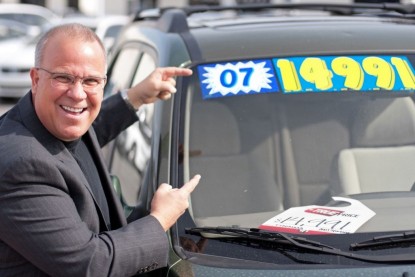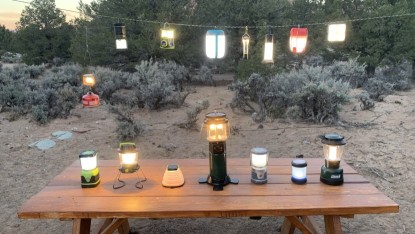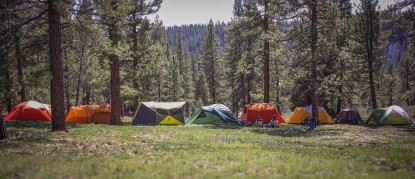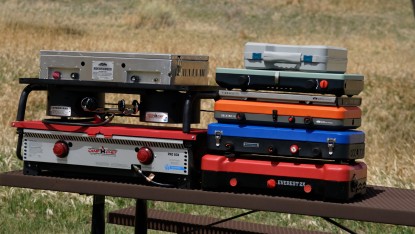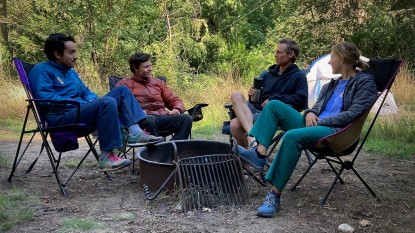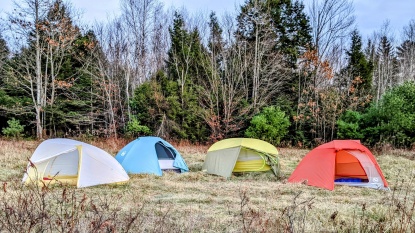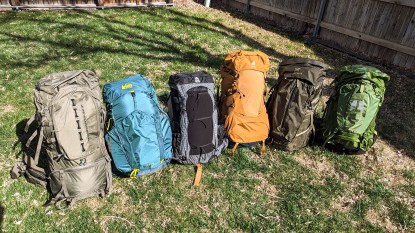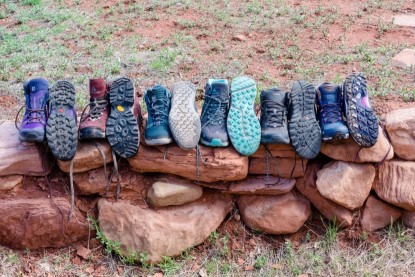How do you determine the right headlamp for you? After putting 27 top headlamps through a detailed side-by-side review over multiple years, we developed a clear picture of the competing product capabilities and which products work best in various situations. In this article, we'll share the insights gained from our extensive testing process.
Why Buy a Headlamp?
The primary advantages of a headlamp over flashlights, a lantern, or using a flashlight app on your cell phone:
- Hands-free — the ability to use both hands is a major advantage over a flashlight, and for certain activities like climbing, hands-free is imperative. Even around the campsite where a lantern can provide general hands-free lighting, the ability to easily direct extra light wherever you'd like, with just a nod of your head, is an advantage.
- Beam Distance — most of the lights over $30 offer a spotlight mode capable of casting an impressively long beam. This can be a big asset for finding things in the dark, such as the poorly marked trail back to your car or campsite.
- Compact and Lightweight — they are easy to fit in your pack, and the lightest weigh less than an ounce.
- Durable — many of the higher quality lights are built tough, offering water resistance sufficient to operate in sustained rain storms (IPX-4), and some are waterproof to one meter depth (IPX-7). This makes them particularly attractive for those going into the backcountry where weather tends to be unpredictable.
A Big Help When Things Go Wrong
To choose the right light for you, we recommend you think about how it might perform when things go wrong. If all you need is some illumination to rummage around the campsite, pretty much any light will do the trick. A good choice for simple utility lighting is the $17 winner of our Best Buy award, the Petzl Tikkina. However, if you spend another $25 or so, you can get a light that will last for years and offer a dramatic upgrade in beam distance, durability, and quality. We think it's worth considering a headlamp as a tool that can make a difference under less than ideal conditions, and invest in a light that will serve you when things go wrong.
The ability to keep both hands free while directing light with your head has real advantages when things go wrong. Consider the possibility of being caught out after dark in the backcountry, with an injured party member or failed equipment, and how a hands-free light might assist you in such a situation. Rather than view the competing lights with its-all-good optimism in mind, we suggest you might be better off framing your purchase decision in consideration of challenging situations you might face: bad weather, cold temperatures, complex trail-finding, injuries, broken equipment or vehicles, and the need for light for much longer than expected.
Types of Products
To narrow down your decision, you'll want to keep in mind the range of features offered by competing products.
- Floodlight — almost every light offers a wide floodlight mode which casts a wide beam at one or more dim settings. This kind of light is ideal for close-proximity use, such as preparing meals at the campsite, rummaging in the tent, or reading. By using a dim setting, you can avoid blinding your camp mates every time you turn your head toward them. You'll also get much longer battery run-time by using the dim setting when you can.
- Spotlight — while a wide beam is great around camp, but when you need to see at a distance, a focused bright beam is ideal. Once you get above $30 street price, pretty much every light offers both a floodlight and a separate spotlight mode. The best lights shine a full football field length (100m), and a few shine a beam over 150 meters. These bright beams are ideal for trail finding situations where the ability to see trail markings at long distance is ideal.
- Red light — about half the lights we tested offer a red LED light mode. There are a few reasons a red light can come in handy. The first is battery life: the red LED is more efficient and can dramatically extend run-time. This can also be useful in a search-and-rescue scenario, because a flashing red LED can be seen at a great distance, and will last the longest. Many people use a red LED to preserve night vision. This has an advantage for star-gazing, since it takes up to an hour for your eyes to get fullly adjusted to the dark, but you may need some light in the meantime. Hunters also rely on red light (as well as green, blue, or yellow under certain conditions), both to preserve night vision and because the red light doesn't spook animals. Experienced hunters can identify the type of animal based on the shine and shape of their eye reflection in red light.
- Waterproof — the lowest cost lights are not waterproof, but most of the lights above $20 street price have an IPX 4 rating, which means they are able to withstand water splashing against the enclosure from any direction. An IPX 4 rating provides sufficient water resistance for continued operation in a rain storm. We put about 20 IPX 4 rated lights in a milk crate and sprayed water at them from all directions for 30 minutes. Not one failed. A handful of high-end lights include an IPX 7 rating, which means they are waterproof down to one meter deep. The IPX 7 rating requires a 30-minute immersion at one meter to pass. One light, the BD Storm, has a IP 67 rating. The “7” in “67” designates the same waterproof to one meter deep as indicated by the IPX 7 rating. The “6” indicates the light is not just waterproof, but also dust tight. By accident, we put an IP67 light in the washing machine (which also turned out to be a good test). It was unaffected.
- Battery Type — most of the lights we tested operate on either AAA or AA alkaline batteries. But a handful of lights, like the Black Diamond Sprinter, the Black Diamond ReVolt, Zebralight H600w Mk IV and the Fenix HP25R offer rechargeable battery options such as Lithium Ion batteries or NIMH. Those lights with AAA or AA batteries will generally work with after-market rechargeable batteries like the well regarded Panasonic Eneloop AAA batteries.
Performance Specifications
There are three key performance specifications on every competing product:
- Lumens
- Beam Distance
- Battery Run-time
Lumens? Meh.
Almost every manufacturer has a specification for the Lumens output of their light. This is a real measurement, obtained from a device called an integrating sphere, that measures the total light energy being emitted from a device in any direction. While it gives you a measure of the total light output, and is a good spec for household light bulbs, it doesn't actually tell you whether the product is going to be useful or not. Why? Because in our field tests we found the best headlamps are those with the best optics, providing a smooth and even light, in your choice of spotlight or wide-beam mode. The lumens measurement does not factor in the quality of the beam pattern, but only the total sum of light in any direction.
Two lights with the exact same lumens can have vastly different light quality depending on the beam width and the optical quality of the lens system. In the end, we feel lumens are not a reliable way to compare performance. Better to look at beam distance instead.
Beam Distance Does Matter, Up to a Point
Beam distance inherently incorporates both the brightness of the light and the ability of the lens to focus the light into a beam. Unfortunately, it doesn't tell you if the optics are high quality, and the beam may contain artifacts that diminish its utility.
You'll find a beam distance specification for every light you might consider, typically one for the high-output spot mode and one for the low-light close-proximity mode. We suggest you pay attention to the maximum beam distance number since it is a relative indicator of performance. However, keep in mind that in our tests we found the manufacturers' specs to most often to be overstated by about 9% on average. We'd recommend you use our beam distance number for comparison, since we tested every light in the exact same way, using the exact same test conditions, light meter, and brand of batteries. Thus, we believe our measurements provide a more fair and reliable basis for side-by-side comparison.
Battery Run-time Specs Are Misleading
Battery run-time is an important consideration, and performance varies considerably from one light to another. The problem is that the manufacturers are using a self-serving definition of “run-time” they invented, rather than using the ANSI FL-1 industry standard specification. The manufacturers' standard makes it easy to design a light that games the system to present unrealistically long run-time values.
Our recommendation is that you use our measurements of battery run-time, and ignore manufacturers' specs. While light experts may debate whether our test methodology is the ideal, it is both independently measured (by us, rather than self-reported figures from the manufacturers themselves), and measured in the same way across every light we tested. We used the ANSI FL-1 definition to determine the time to stop the clock on run-time.
We have a separate article that covers Why Headlamp Claims are Deceptive in detail. If you're interested in more background info, give it a read.
How to Choose the Best Headlamp for Your Needs
So, where does this all background advice leave us, and you, in terms of which product to buy?
Let us break it down for you.
First, Consider Beam Distance
We think first of light in situations where something has gone wrong. If you are the kind of person who may find themselves off the beaten path after sundown, then beam distance is crucial. It is the single most important factor in trail finding performance (optics quality is second). There is no substitute for being able to see far ahead to avoid getting lost.
Top performing lights for beam distance and in our trail finding tests include the Zebralight, which won a Top Pick award, and the Fenix HP25R which offers amazing brightness for 2.5 hours awards.
Of course, not everyone really needs a maximum distance beam.
If your nighttime hiking will be on well-marked trails, then you might want to consider one of our two Editors' Choice winners, the Black Diamond Storm or the Spot. Both are top performing lights, at home and on the trail as well as around the campsite, and sell for less than $50.
If you are going to use your light mostly around the campsite and around home as a general utility light, then a low-cost light like the Petzl Tikkina, available for about $17 and winner of our Best Buy award, would do the trick.
Durability
We think the next decision criteria is about durability. Again, we're thinking about survival when things go wrong, and one of those considerations is bad weather. Imagine yourself hiking out at night when it starts pouring rain. Will your light still work?
Based on our tests, we're confident than any IPX 4 rated (an IPX # greater than 4 is even better) will hold up in a rainstorm. Not all top performing lights offer an IPX 4 rating. The Coast HL7 is rated as “water resistant” but not as passing the IPX 4 rating tests. Placed under a rain jacket hood the Coast would probably do just fine, but a light rated IPX 4 or better is a safer bet.
For the best durability, consider one of the IPX 7 rated lights such as the Zebralight or Black Diamond Storm. These are fully submersible to one meter, and thus can be expected to hold up to being dropped in a creek, as well as a sustained all-night storm. By far the most durable light we tested is the Zebralight H600.The Zebralight is rated to IPX 8, which specifies that the product be waterproof to a submersion of more than one meter. And, its metal casing and precision fit and finish set it apart from plastic lights.
The risk averse backcountry enthusiast might consider throwing the ultralight Petzl e+LITE in as a backup plan. It weighs only an ounce, and carries an impressive IPX7 waterproof rating. Plus the CR2032 watch batteries used in the e+LITE are spec'ed to be good even if stored for up to 10 years, so you can be confident your stashed backup e+LITE's batteries will still fire up years later.
Battery Life
Battery run-time is not a big consideration for everyone. If you are car camping and bring some extra batteries along, you are unlikely to ever have a problem (and in most cases, you won't even need to tap into your extra battery stash).
But, when things go wrong, battery run-time matters. We keep the risk of an all-night hike out of the backcountry, with an injured party member and/or failed equipment in mind. Our ideal light can sustain output in the high setting all night. In our tests, we found the Black Diamond Icon to be a unique light that combined outstanding brightness and trail finding capability in high-mode, with battery run-time that could legitimately operate all night long.
Other lights may be able to get you through the night by switching to low-mode to conserve batteries, and/or taking along an extra set of batteries. An extra set of 3 AAA batteries adds just 1.2 oz (or 35 grams) to your pack.
Rechargeable batteries are generally not a great option if you are worried about all-night performance. However, the exception to the rule may be the Zebralight which lasted a bright 5 hours in our high mode run-time test. Bring an extra 18650 Li-ion battery, and the Zebralight is ready to take on a full night while delivering exceptional brightness.
Special Activity Requirements
For some types of use, the above criteria are trumped by special activity requirements.
Running
A frequent runner might be heading out at night or early in the morning more than three times a week. In this kind of situation, the cost of batteries becomes a significant factor, and comfort on the head is another key consideration. For runners, we don't think there is a better light on the market than the Black Diamond Sprinter, which earned our Top Pick award for runners. It is rechargeable, saving you money in the long-term on batteries, and nicely balanced on the head by placing the battery on the back of the head to counter-balance the light in the front. It includes an optional top band to further stabilize it when running, and a red tail light as an added safety feature to help cars see you.
Remote Travel
Replacement batteries are an issue when traveling to some remote and/or international destinations. A great option in this kind of situation is a combining a rechargeable light with a solar charger. The Black Diamond ReVolt is our favorite for this kind of situation, with its flexible battery options, long battery run-time, and reasonable price.
Ultralight
Weight and size is an issue for every backpacker or climber, even if you're not doing the full ultralight “I-cut-off-the-handle-of-my-toothbrush” thing to save weight. If weight and size are top considerations for you, there is no better option than the Petzl e+LITE. Weighing only an ounce (27 grams), it offers small size, a reasonable light, and rock-solid durability.






